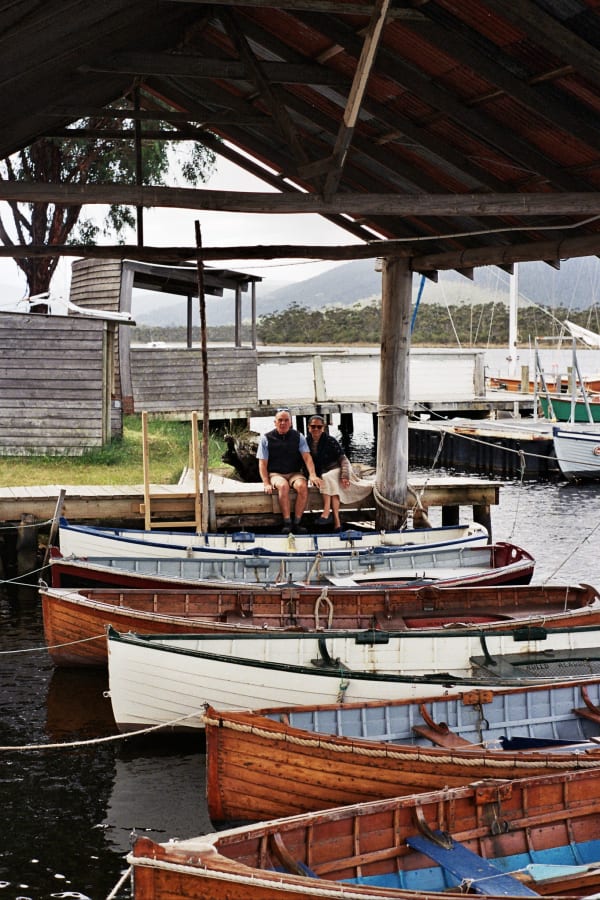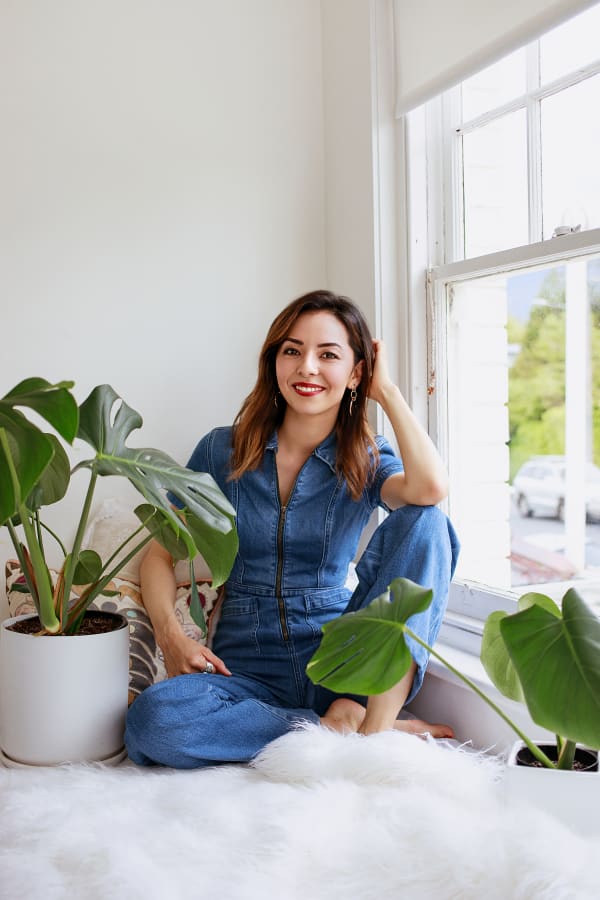Island dwellers often talk about the way Tasmania slowly, softly enfolds its visitors, keeping them here longer than expected, sometimes forever. It took a global pandemic for me to experience this firsthand. For a decade, Tasmania was just a place I retreated to when I needed respite from my peripatetic lifestyle. During those years I lived in Bristol, Boston, Moscow, Los Angeles, Singapore, London and Shanghai, pursuing university degrees, an acting career, and ill-fated relationships.
My homes included bleak university dormitories, timber buildings blanketed with snow, free-spirited California share houses, and tropical condos flanked by rain trees. The only constant in my life was spending summers at my parents’ home in Sandy Bay. For a meandering month (or three), I surrendered to the gentler rhythms of island life, gathering energy for my next move.
Tasmania was a complete escape since I hardly knew anyone on the island. I was born in Bendigo and spent my teenage years in Townsville and Sydney. After I finished high school, my parents relocated to Hobart. They had toyed with the idea of moving here ever since our first visit to Tasmania in late 1996 when I was four years old. The air was heavy with recent tragedy, and yet the quiet allure of the island charmed my parents.
I remember little about that trip other than dancing till late at the Spirit of Tasmania’s discotheque. By all accounts, I had a ball. Holiday snaps show me posing in flamboyant red jeans at Richmond Bridge, squatting ecstatically in the sand at Pirates Bay, and leaning smugly against a stretch limo at Wrest Point.
For my father, the lure of Tasmania was the sea. Dad is a mad sailor. Our family once lived onboard a 43-foot catamaran while cruising down the coast from Townsville to Sydney. Water lapped at my berth window and I felt queasy doing homework. After a year and half living on the yacht, dad decided big boats couldn’t satisfy his need for speed. In Hobart he could zip around in an off-the-beach catamaran at Lauderdale, or thrash about on the Derwent on his bright red trimaran, Salty Rat.

. . .
It was while whitewater rafting in Taiwan in the late 1980s that my Anglo-Australian father met my Singaporean-Chinese mother. Born into a family of migrants, mum has lived in six countries (if she’s the tree, I’m the proverbial apple). She can’t stay under any one roof longer than a few weeks without planning a holiday. When things get too static, she has been known to surprise dad by spontaneously buying a new house (usually while he is out sailing).
Mum lives by a loose system of feng shui. Our new home in Hobart was excellently positioned, facing the sea with its back to the mountain. She is also dotty about Huon pine and was in a prime location to continue her collection of rolling pins and chopping boards.
I did not share my parents’ enthusiasms. To my teenage mind, Tasmania equalled social death. Within a few months, I departed for university in England, trading this island for a colder, drearier one.
My summer sojourns to Tasmania were usually characterised by solitude and voracious reading. Some years I returned with a boyfriend from overseas. My Mexican-American ex grew up outside Los Angeles in a pocket of suburbia bordered by eight-lane highways. At Freycinet we camped on the sand beside impossibly clear water and were woken at night by possums attacking a poorly-positioned food bag. For months afterwards he dreamt of returning to Tasmania to hike the Overland Track.
Another year I returned home with a British-Punjabi partner who had grown up in a town as bleak as its name: Gravesend. We scrambled to the summit of Cradle Mountain before crossing to the coast to perch on violently-orange rocks at the Bay of Fires. The sense of wonder with which newcomers experienced the island made me proud and protective of its fierce beauty.
In 2018, in the aftermath of an unforeseen break-up, I returned from London to Hobart. I signed up to volunteer at a 10-day Vipassana silent meditation retreat at Dhamma Pabha, a small centre tucked away in the bush at Dromedary. I meditated, cleaned bathrooms, and shared stories with a diverse crew of volunteers as we prepared meals. On New Year’s Eve we drank homemade water kefir and were tucked up in bed well before midnight.

The only threat to our tranquility was an encroaching bush fire. One day we had to move the meditators off Dhamma Pabha to a nearby community hall — without breaking their silence. We relocated with remarkable synchronicity and the fire never reached the centre. Those 10 days strengthened my sense that there was some kind of intangible magic at play on the island.
As summer ended I departed, this time for Shanghai to study Mandarin and kung fu. From the moment I arrived in China’s most populated, city I entered a whirlwind of language study, martial arts training and nights out that often ended with me practising Mandarin with taxi drivers as we hurtled along elevated highways at daybreak.
I revelled in Shanghai’s relentless hedonism for almost a year until I began to hear about a mysterious virus. The city’s entrepreneurial zeal was replaced by unnerving stillness, punctuated by frantic moments of mask-buying. I surveyed my inner-city dorm room and imagined being trapped there for months, surviving on cup noodles. Within days, I had thrown as many belongings as possible into a suitcase, and booked a flight home.
I landed in Hobart on one of those rare summer days when the temperature lingers in the high 30s. Waiting to disembark, we heard an announcement: “A passenger from China has symptoms of coronavirus. Please remain seated until medical professionals arrive.” The tension was palpable. At one point the air-conditioning cut out. After three hours we disembarked, sweaty and confused. Days later I received a text from the airline – we had not been exposed to coronavirus.
For a few weeks I entertained notions of returning to China. As that possibility faded, I felt a mixture of heartbreak and unexpected relief. My wings had been clipped. With no choice but to settle in at my parents’ house, I surrendered to fate. I read, cooked and stopped drinking alcohol. I learned to do “nothing”, and sat on my window ledge mesmerised by the tangerine sky reflected in the Derwent’s silky waters. Every day I wore one of three old woollen jumpers, paint-splattered track pants and hiking socks.
When restrictions eased, my parents and I escaped to the Tasman Peninsula for a few days. Gliding by Port Arthur in our kayaks we heard piano music emanating from the historic ruins. The site was deserted but for a handful of staff who told us Kelvin Smith was playing his roving Strauss, A Piano of Tasmania. We bobbed around, letting the music transport us in that most poignant of settings.

. . .
Moving from a metropolis of 24 million to a city of 200,000 takes some adjustment. I loved the anonymity of Shanghai, the rush of striding past scores of unknown faces in metro tunnels. As I began to form connections in Tasmania, I started running into new acquaintances with unaccustomed frequency, even on seemingly secluded beaches.
I’ve since come to appreciate these inevitable daily interactions and the sense of community they invoke. Friends in Hobart often text me telling me to look at a rainbow over the Derwent, or a dusting of snow on kunanyi. The island itself seems to cradle you within its hills and valleys, winding rivers and curving bays. The sky feels more enveloping than the expansive blue of the mainland (not to mention the toxic haze of China).
It is said that islands can be limiting, but Tasmania’s seclusion has emboldened me to be more exploratory and open-minded in my creative work. I’m also astounded by the talent Tasmania has birthed and attracted. Recently, I was invited to Tarraleah Artist Residency as part of a multi-generational group of performers. Our mentors were established names with formidable credentials. In a big city they might have seemed unapproachable; in Tasmania you chat to them over a pub steak.
Tasmania is often associated with artists late in their careers, but less is said about how nourishing an environment for younger creatives. It sometimes feels like a parallel universe, less consumed by vanity and pretension. In my dance class at Mature Artists Dance Experience, I’m the youngest student by a couple of decades and feel a total freedom to move, fail, grow. The smaller, more human scale of Tasmania is not so much restrictive as encouraging; creative projects can have great potential for community impact and involvement.
Recently, for the first time since Shanghai, I found myself in a roomful of Mandarin-speakers. Along with 30 or so young Chinese migrants, I was dressed in traditional Han costumes at a restaurant in Bellerive. The organiser of the event was thrilled to have “a local” in attendance. He was keen to share his passion for historic Chinese dress with Tasmanians, but he wasn’t quite sure how.
I realised there might be a place for me on the island as someone who can help to bridge the diverse communities that call Tasmania home. Soon after, I spoke to Chris Champion about writing for Forty South’s online platform, focussing on stories at the intersection of Tasmanian life and migrant experience. The result is fortysouth.com.au/stephanie-jack.
A local children’s author once told me, “Tasmanians never quite discovered cynicism.” One definition of cynicism is the inclination to believe that people are motivated purely by self-interest. Residents of this island still trust in the goodwill and generosity of others. By the time this article is published, Tasmania will have opened its borders and my enforced period of idyllic stasis will end. I’ll be able to fly away, but I’m not sure I will. The island has worked its charm.

Stephanie Jack is an Australian-Singaporean actor and writer. She has lived in six countries and on board a yacht. She is a graduate of Harvard’s American Repertory Theater Institute, and the creator of Mixed Up, a YouTube series exploring mixed race identity. More about her can be found at stephanie-jack.com.








